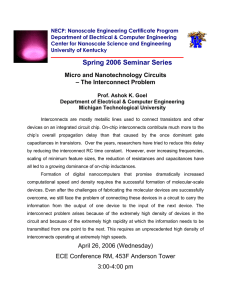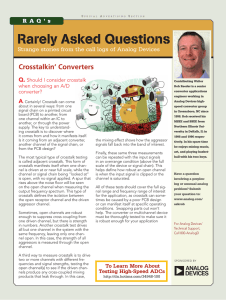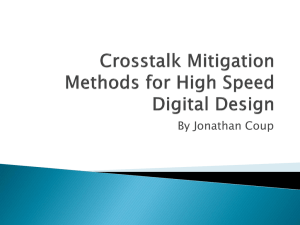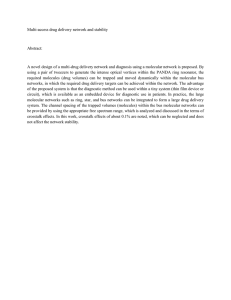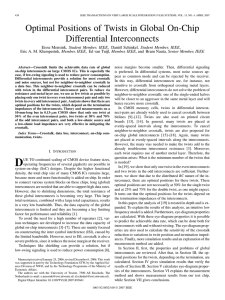Optimally-Placed Twists in Global On
advertisement
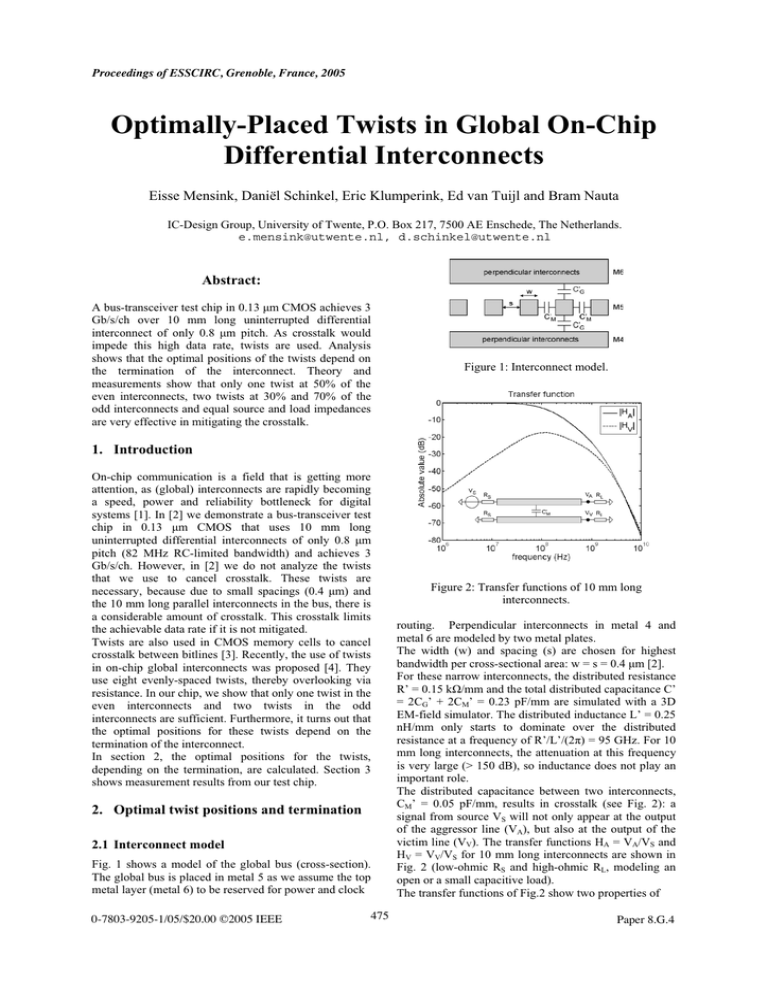
Proceedings of ESSCIRC, Grenoble, France, 2005 Optimally-Placed Twists in Global On-Chip Differential Interconnects Eisse Mensink, Daniël Schinkel, Eric Klumperink, Ed van Tuijl and Bram Nauta IC-Design Group, University of Twente, P.O. Box 217, 7500 AE Enschede, The Netherlands. e.mensink@utwente.nl, d.schinkel@utwente.nl Abstract: A bus-transceiver test chip in 0.13 µm CMOS achieves 3 Gb/s/ch over 10 mm long uninterrupted differential interconnect of only 0.8 µm pitch. As crosstalk would impede this high data rate, twists are used. Analysis shows that the optimal positions of the twists depend on the termination of the interconnect. Theory and measurements show that only one twist at 50% of the even interconnects, two twists at 30% and 70% of the odd interconnects and equal source and load impedances are very effective in mitigating the crosstalk. Figure 1: Interconnect model. 1. Introduction On-chip communication is a field that is getting more attention, as (global) interconnects are rapidly becoming a speed, power and reliability bottleneck for digital systems [1]. In [2] we demonstrate a bus-transceiver test chip in 0.13 µm CMOS that uses 10 mm long uninterrupted differential interconnects of only 0.8 µm pitch (82 MHz RC-limited bandwidth) and achieves 3 Gb/s/ch. However, in [2] we do not analyze the twists that we use to cancel crosstalk. These twists are necessary, because due to small spacings (0.4 µm) and the 10 mm long parallel interconnects in the bus, there is a considerable amount of crosstalk. This crosstalk limits the achievable data rate if it is not mitigated. Twists are also used in CMOS memory cells to cancel crosstalk between bitlines [3]. Recently, the use of twists in on-chip global interconnects was proposed [4]. They use eight evenly-spaced twists, thereby overlooking via resistance. In our chip, we show that only one twist in the even interconnects and two twists in the odd interconnects are sufficient. Furthermore, it turns out that the optimal positions for these twists depend on the termination of the interconnect. In section 2, the optimal positions for the twists, depending on the termination, are calculated. Section 3 shows measurement results from our test chip. 2. Optimal twist positions and termination 2.1 Interconnect model Fig. 1 shows a model of the global bus (cross-section). The global bus is placed in metal 5 as we assume the top metal layer (metal 6) to be reserved for power and clock 0-7803-9205-1/05/$20.00 ©2005 IEEE 475 Figure 2: Transfer functions of 10 mm long interconnects. routing. Perpendicular interconnects in metal 4 and metal 6 are modeled by two metal plates. The width (w) and spacing (s) are chosen for highest bandwidth per cross-sectional area: w = s = 0.4 µm [2]. For these narrow interconnects, the distributed resistance R’ = 0.15 kȍ/mm and the total distributed capacitance C’ = 2CG’ + 2CM’ = 0.23 pF/mm are simulated with a 3D EM-field simulator. The distributed inductance L’ = 0.25 nH/mm only starts to dominate over the distributed resistance at a frequency of R’/L’/(2ʌ) = 95 GHz. For 10 mm long interconnects, the attenuation at this frequency is very large (> 150 dB), so inductance does not play an important role. The distributed capacitance between two interconnects, CM’ = 0.05 pF/mm, results in crosstalk (see Fig. 2): a signal from source VS will not only appear at the output of the aggressor line (VA), but also at the output of the victim line (VV). The transfer functions HA = VA/VS and HV = VV/VS for 10 mm long interconnects are shown in Fig. 2 (low-ohmic RS and high-ohmic RL, modeling an open or a small capacitive load). The transfer functions of Fig.2 show two properties of Paper 8.G.4 Proceedings of ESSCIRC, Grenoble, France, 2005 the interconnect: First, the interconnect has a limited bandwidth of only 100 MHz (82 MHz for a differential interconnect) that limits the achievable data rate. In order to have a data rate of 3 Gb/s, we make use of a lowohmic RL and pulse-width (PW) equalization [2]. Second, the neighboring interconnect creates severe crosstalk. Especially for frequencies above 1 GHz, the transfer functions HA and HV are almost equal. Therefore, in order to achieve the data rate of 3 Gb/s, it is necessary to mitigate the crosstalk. 2.2 Twist analysis The neighbor-to-neighbor crosstalk in the bus is reduced by using differential interconnects with twists. Fig. 3 shows how the twists are organized (interconnects in metal 5 and part of the twists in metal 4). Every differential interconnect has only one or two twists (alternately). The positions of the twists are at x1*lT, x2*lT and x3*lT, with lT the total length of the interconnect. In this section, we show how to calculate the transfer functions HA and HV for differential interconnects with twists. First, we calculate the transfer functions HA+ = out+/VS1 and HA− = out−/VS1 with VS2 = 0 (see Fig. 3). Then, HA = HA+ – HA−. After that, the transfer functions HV+ = out+/VS2 and HV− = out−/VS2 with VS1 = 0 are calculated. For differential mode (DM) crosstalk HV = HV+ – HV− and for common mode (CM) crosstalk HV = ½*(HV+ + HV−). HA+, HV+, HA− and HV− can be found by using an even and odd analysis: HA+/− = ½*(Heven+/− + Hodd+/−) and HV+/− = ½*(Heven+/− – Hodd+/−) where Heven+/− = (out+/−)/VS1 with VS2 = VS1 and Hodd+/− = (out+/−)/VS1 with VS2 = –VS1. In the remainder of this section we show how to calculate Heven+/− and Hodd+/−. The characteristic impedance and propagation constant of a distributed RC-line are [5]: ZC = γ= Figure 3: General model for twisted interconnects. With these values for M and lk, the s-parameters [5] of every section k are (see bottom of Fig. 3): S ijk = SS = 1 2 3 4 ZS − Z0 Z − Z0 , SL = L . ZS + Z0 Z L + Z0 Now, with the help of Mason’s Rule [5], the transfer functions Heven+/− and Hodd+/− can be found and thus HA and HV can be calculated. As the formulas are very complex, they are not shown here. 2.3 Signal-to-Crosstalk-Ratio With the help of these transfer functions, the optimal positions for x1, x2 and x3 can be found. We define the signal-to-crosstalk-ratio (SCR) as follows: M is dependent on the signal that is on the neighboring interconnects (Miller multiplication of capacitance CM’). The twists divide the interconnect into four sections. For every section k, M can have a different value. These values of M are shown in the table below. Also, the length of every section is given. M Hodd+ Heven− 3 4 3 2 2 3 4 3 × Z0 is a reference impedance and can be chosen freely. The source and load impedance are reflected in SS and S L: jωR' (2C G '+ MC M ' ) . Heven+ 3 3 4 2 2 Z 0 Z Ck cosh(γ k l k ) + ( Z 0 2 + Z Ck 2 ) sinh(γ k lk ) º ª( Z 2 − Z 2 ) sinh(γ l ) 2 Z 0 Z Ck 0 k k » « Ck 2 2 2 Z 0 Z Ck ( Z Ck − Z 0 ) sinh(γ k l k )»¼ «¬ R' and jω (2C G '+ MC M ' ) k 1 ∞ signal power = SCR = crosstalk power lk Hodd− 2 4 3 3 ³ X ( f ) H A ( f )df 0 ∞ ³ X ( f ) H V ( f )df 0 x1*lT (x2 – x1)*lT (x3 – x2)*lT (1 – x3)*lT where X(f) is the power spectral density of the input signal. Fig. 4 shows the DM SCR (differential mode crosstalk) as a function of x2. In this case, x1 = 0, x3 = 1, lT = 10 mm and RS = 50 ȍ. The SCR is highest if x2 is 0.5 and RL = RS. However, if RL is larger then RS, the optimum Table 1: Values for M and lk for every section k. 476 Proceedings of ESSCIRC, Grenoble, France, 2005 Figure 4: Calculated DM SCR as a function of x2 and RL (x1 = 0, x3 = 1, lT = 10 mm and RS = 50 ȍ). Figure 5: Calculated contour plot of SCR as a function of x1 and x3 (x2 = 0.5, lT = 10 mm and RS = RL = 50 ȍ). Figure 6: 3D EM-field simulation step responses for different positions of the twist (x1-x2-x3) and for two different load resistances. Both differential mode (DM) and common-mode (CM) step responses are shown. The length of the interconnects lT = 1 mm. Figure 7: Bus configuration of test chip. value for x2 is shifted towards 0.7 and the peak value of the SCR decreases. Note that the optimal case, one twist at x2 = 0.5 and choosing RL = RS, nicely coincides with the fact that for highest bandwidth, both RS and RL should be chosen low-ohmic [2]. DM crosstalk can be cancelled with the twist at x2, but there will still be CM (common mode) crosstalk. This can be removed by the twists at x1 and x3. Fig. 5 shows the SCR for both DM crosstalk and for CM crosstalk as a function of x1 and x3 (x2 = 0.5 and RL = RS). The figure shows that the DM crosstalk is canceled if x3 = 1 – x1. On this line, the CM crosstalk is minimal at x1 § 0.3 and x3 § 0.7. So, the optimal twist positions are at x1 = 0.3, x2 = 0.5, x3 = 0.7 and RL = RS. However, the SCR remains adequate (>35 dB) for large variations in xi and RL (Figs. 4 and 5). 2.4 3D EM-field simulations In order to check the optimal positions, two differential interconnects have been drawn in a 3D EM-Field simulator. The length lT is only 1 mm to limit the simulation time. Note that for lT = 1 mm, the crosstalk 477 voltage is much lower than for lT = 10 mm. One of the differential interconnects has one twist and the other has two twists. Fig. 6 shows the simulated crosstalk voltage (step response) for different positions of the twists (RS = 50 ȍ). For DM crosstalk, the optimal position of the twist (x2) is at 0.5 for an RL of 50 ȍ and between 0.6 and 0.7 for an RL of 20 kȍ. This coincides with the theory, as the model of the previous section predicts 0.5 and 0.64 respectively. For CM crosstalk, the optimal positions of the twists (x1 and x3) are at 0.3 and 0.7 for an RL of 50 ȍ and at 0.35 and 0.8 for an RL of 20 kȍ. Again, this coincides with the theory that predicts x1 = 0.27 and x3 = 0.73 for an RL of 50 ȍ and x1 = 0.37 and x3 = 0.82 for an RL of 20 kȍ. 3. Measurements On a test chip [2], a bus of seven 10 mm long differential interconnects is measured. The seven channels (see Fig. 7) are driven by inverters with an RS of 65 ȍ. The RL of about 150 ȍ is made with inverters with a feedback resistor. So both RS and RL are low-ohmic. The low-ohmic termination in combination with pulse- Proceedings of ESSCIRC, Grenoble, France, 2005 Figure 8: Measured transfer functions on output of channel 6. Figure 9: Measured transfer function on output of channel 1. width equalization is used to achieve a data rate of 3 Gb/s. This data rate is measured on channel 4, as described in [2]. In this paper, we show the results of measurements on channels 1 and 6. These measurements show the effectiveness of the twists. Fig. 8 shows the measured transfer function from ch. 6 and the crosstalk transfer functions from ch. 5 and 7 to ch. 6. As expected, the crosstalk from ch. 5 is less than the crosstalk from ch. 7 (double twist in ch. 5 reduces CM crosstalk, see top Fig. 8) and both the crosstalk from ch. 5 and ch. 7 is reduced for the differential output (single twist in ch. 6 reduces DM crosstalk, see bottom Fig. 8). The transfer functions of Fig. 9 have a smaller bandwidth due to the high-ohmic termination of ch. 1. There is more crosstalk from ch. 2 on out1+ then on out1−, because out1− has no signal carrying neighbor. The bottom graph shows that the crosstalk is not reduced for the differential output (no twist in ch. 1). In Fig. 10 the measured single ended (SE) output and the differential (DIFF) output of ch. 6 are plotted in eyediagrams for a data rate of 2.5 Gb/s. For reliable communication, the eye should be open. The eyediagram for the SE output is almost closed (crosstalk from ch. 7). Looking at the DIFF output, the influence of the twist is seen. The eye is almost completely open. Figure 10: Single-ended (SE) and differential (DIFF) eye-diagram measurements. 4. Conclusions By using pulse-width equalization and low-ohmic termination, we achieve a data rate of 3 Gb/s over 10 mm long differential interconnects with a bandwidth of only 82 MHz [2]. However, because of the small spacing, long interconnects and high data rate, the crosstalk is considerable. Therefore, in order to achieve 3 Gb/s the crosstalk has to be mitigated also. The twists that we use for this are analyzed in this paper. Our analysis shows that the optimal positions of the twists depend on the termination of the interconnect. Differential mode crosstalk can be canceled with only one twist at 50% by choosing equal load and source resistances. Two twists in the neighboring interconnects at 30% and 70% reduce common mode crosstalk. Measurements show the 478 effectiveness of the twists. 5. Acknowledgements This research is supported by the Technology Foundation STW, applied science division of NWO and the technology programme of the Ministry of Economic Affairs. Authors thank Philips Research for chip fabrication. References: [1] R. Ho, K.W. Mai, and M.A. Horowitz, “The future of wires,” Proc. IEEE, pp. 490-504, April 2001. [2] D. Schinkel, E. Mensink, E. Klumperink, E. van Tuijl, and B. Nauta, “A 3Gb/s/ch transceiver for RClimited on-chip interconnects,” ISSCC Dig. Tech. Papers, pp. 386-387, Feb. 2005. [3] M. Aoki et. al., “A 60-ns 16-Mbit CMOS DRAM with a Transposed Data-Line Structure,” IEEE J. Solid-State Circuits, vol. 23, no. 5, pp. 1113-1119, Oct. 1988. [4] R. Ho, K. Mai, M. Horowitz, “Efficient On-Chip Global Interconnects,” IEEE Symposium on VLSI Circuits, June 2003. [5] P.A. Rizzi, Microwave Engineering: Passive Circuits, pp. 168-176, 541-548, Prentice-Hall, 1988.
